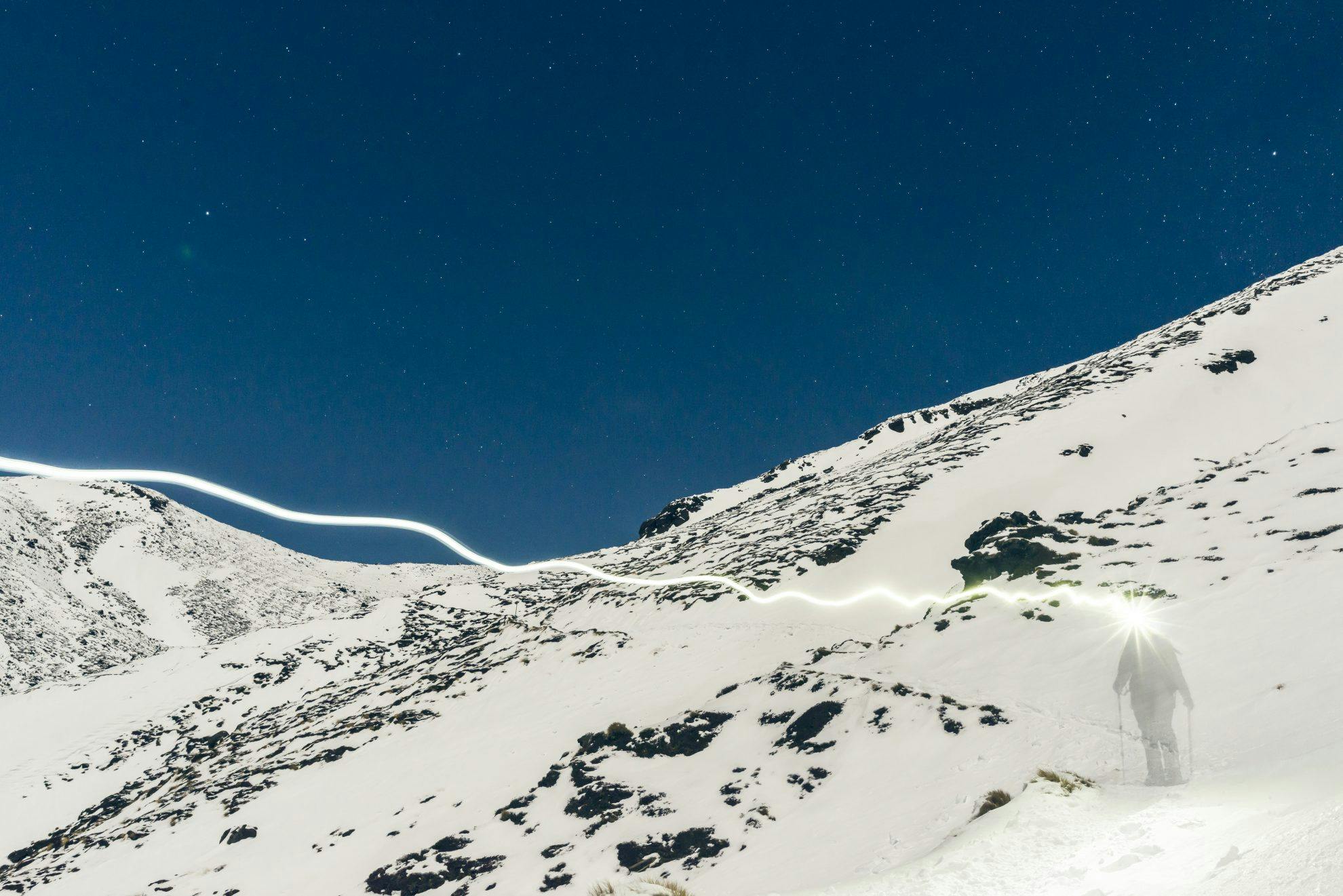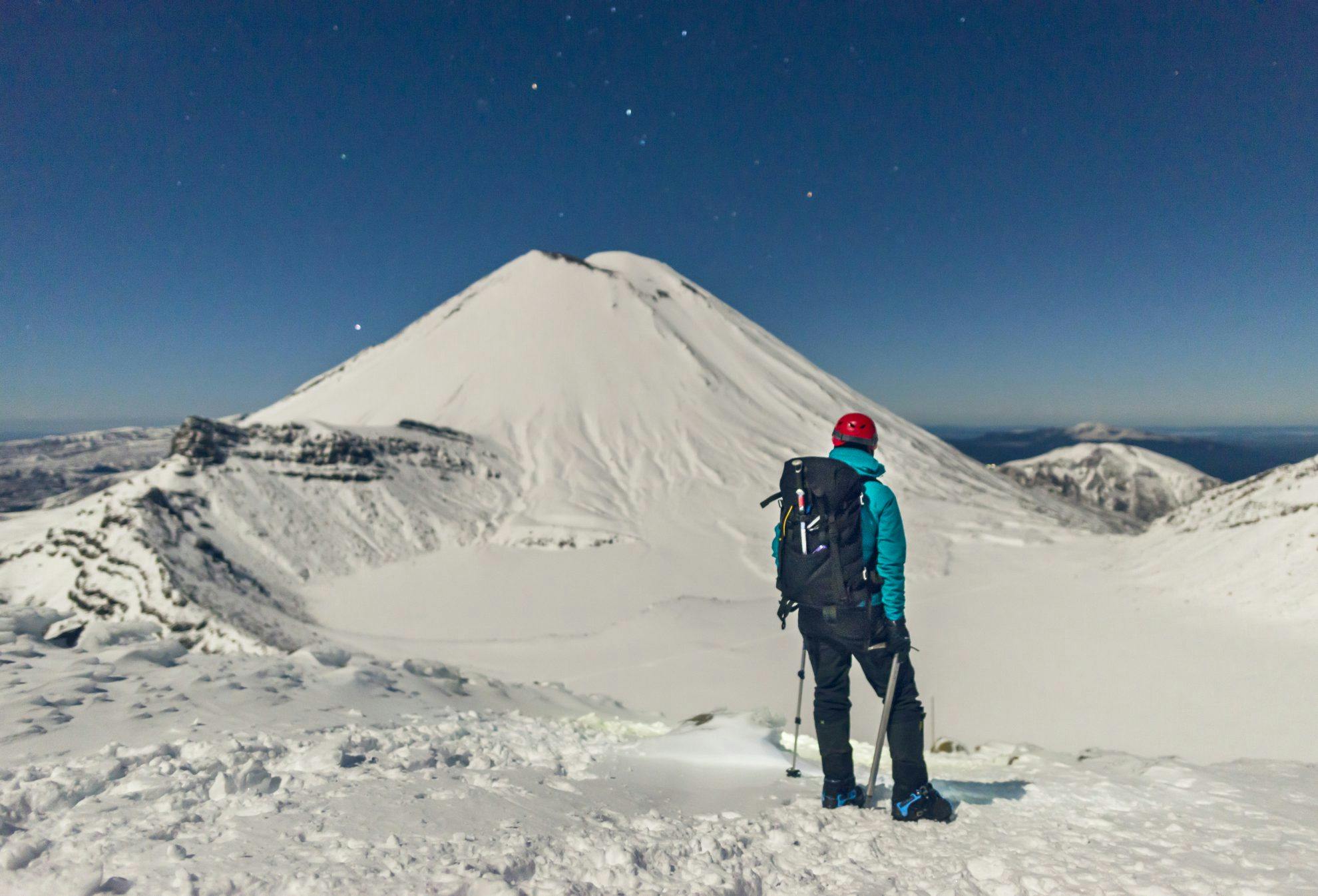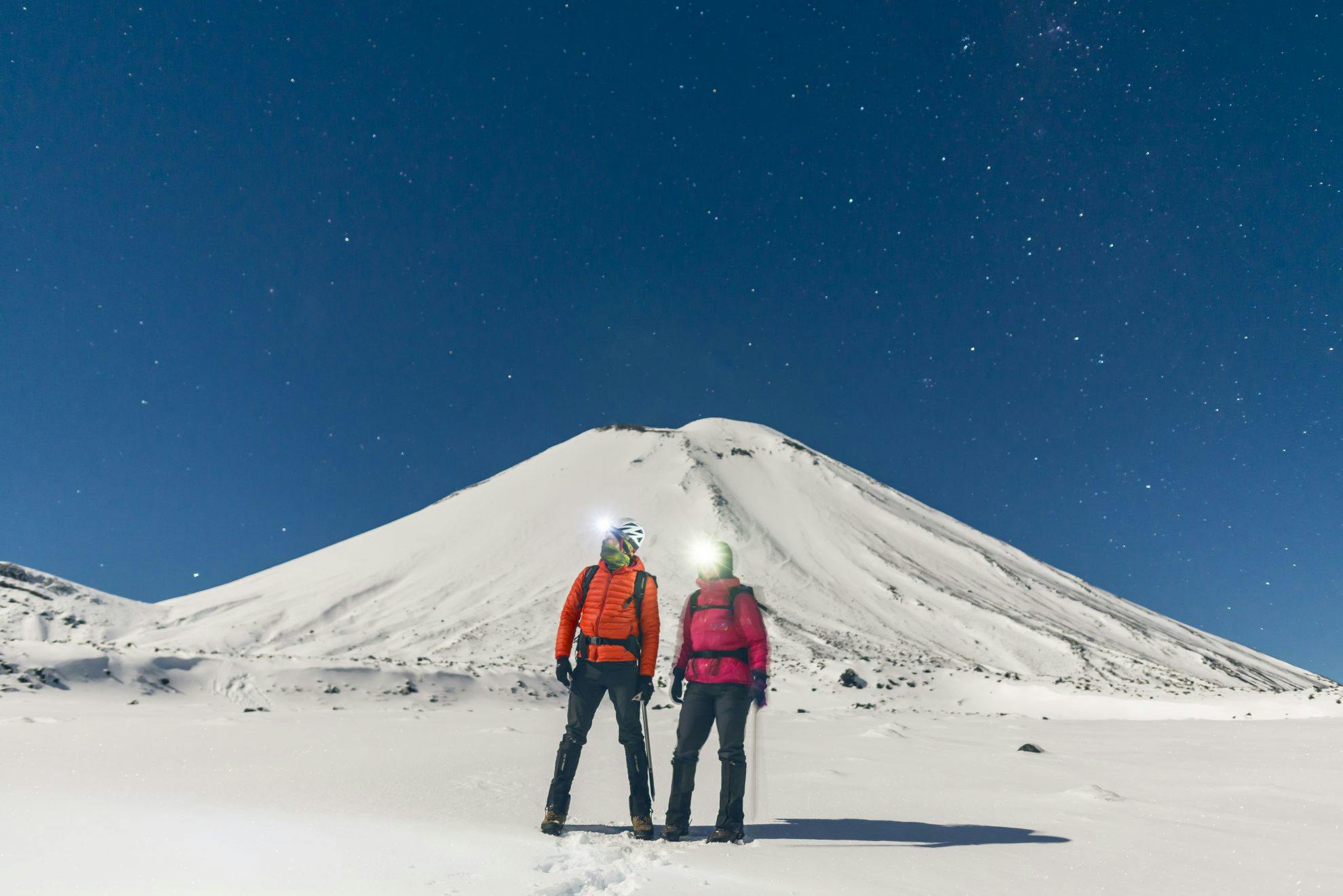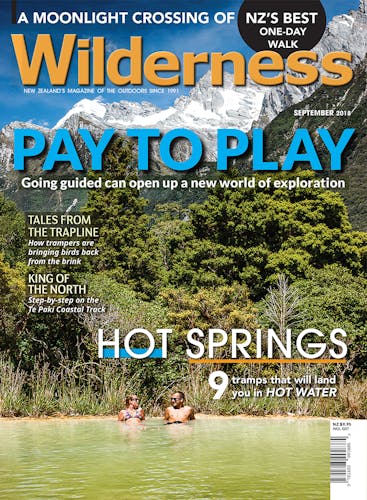In which Hazel Phillips does the Tongariro Moonlight Crossing and hallucinates a dancing gnome on Whakapapa
Sometimes the best trips are born out of someone advising you not to do it. I don’t mean in a safety sense – safety is no accident, after all – but in the sense of knowing there’s an obstacle and being able to overcome it.
I’d long been captivated by the idea of doing the Tongariro Alpine Crossing in winter and by moonlight. Friends reckoned that under a full moon, the snow lights up and you barely need a headlamp. With a starry sky and a lack of crowds there were all the ingredients to cook up the trip of a lifetime.
The obstacle? Friends reckoned it was the coldest thing they’d ever done. “It’s brutal,” said one. “I wasn’t prepared for just how brutal, and I was freezing the entire time.”
Said another: “Sure, it’s beautiful, but you’ll freeze your nuts off.”
Nuts or not, the idea stuck in my head for years. I watched and waited; every full moon every winter for four years, I eyed up the forecast. But each winter the magical trifecta eluded me; decent snow cover, a full moon, and the spare time to do the mission.
Then my vigilance was rewarded. It was late June and there had been a thorough snow dump down below 1000m, with a full moon looming for Thursday night, but Friday night would also work. The snow forecasting websites and Metservice predicted 40km/h winds for midnight at Red Crater, and my buddy Mike and I watched nervously as it oscillated between 40km/h and 0km/h.
Finally, the wind forecast settled at 0km/h, with clear skies. The avalanche advisory dropped from ‘considerable’ to ‘low’ below 2000m. We decided to give it a nudge, with a quiet agreement not to broadcast our mission in case it all fell to pieces. Only Mike’s wife knew, for intentions purposes. Both of us felt that 0km/h winds at Red Crater was an impossible task for the central mountains. We’d believe it when we saw it.
I packed cautiously for the trip, overdoing it on the warm stuff and safety gear just in case we came to grief somehow. Mike ruined himself by biking the better part of the 42 Traverse during the day on Friday, but after some restorative fish and chips and nachos at Schnapps Bar in National Park, we were stuffed and ready to womble.

Starting up the Mangatepopo Valley, it was a very chilly -1°C. The ground was frozen and the snow cover plentiful. It took me until Soda Springs to properly start to defrost – my hands losing feeling and my toes protesting even though they were wrapped up in two pairs of socks and solid tramping boots.
The moon began to peek at us from above the Devil’s Staircase. Standing still, you could actually see it move. Gradually the moonlight bathed us and although I kept my headlamp going until South Crater, there was largely no need for any other light source.
Once in South Crater, the terrain became eerie and ghostlike. We could see huge expanses of snow and no other humans at all. At one stage we thought we saw others in the distance, but later decided the shining lights had actually been our headlamps reflecting off track markers at the other end of the crater. We stopped for a few minutes to take photos in front of Mt Ngauruhoe, a cold undertaking but one we were later happy to have bothered with. “I’ve discovered through bitter experience that the best time to take a photo is when you really don’t want to bother with it,” said Mike, who’s a professional photographer.
I kept warm between photos by doing the ‘cow-milking ice climber’, a movement some ice climbers taught me that warms you up swiftly (make a cow-milking motion with your hands and arms, and squat down and up quickly. It’s important to not get filmed or photographed while doing this).
The next part of the mission was the crux: up and over Red Crater, 1868m altitude. I was astounded to see that the crater actually steams at the top – perhaps I’d never stopped long enough to look at it before, or perhaps it was cold enough to create a contrast between the cold air and the hot steam. Red Crater was stripped back to hard snow and ice, making decent conditions for cramponing down past Emerald Lakes. We stopped for a quick snack break at the Oturere junction, me frantically performing the cow milking routine to stay warm while also trying to eat frozen chocolate biscuits without choking. Mike was eating and behaving sensibly.
Motoring up past Blue Lake, which was around 90 per cent frozen, we kept crampons on until well below Ketetahi Shelter.
Mike, tired from his bike ride earlier that day, began to fade and yawn after Ketetahi, but I was still so keyed up on the adventure that I was as wide awake as a possum in headlights. The section past Ketetahi is arguably the least interesting part of the Crossing, and once you enter the bush it’s basically just a night tramp.
We came off the track around 3.15am and enthusiastically agreed that we could never, ever repeat the trip, as conditions could never be that good again. I’ve done the crossing a bunch of times in different conditions and configurations, but I’ve never had zero wind on Red Crater. Not a cloud in the sky. Not another single human being on the track. Totally still and quiet, with the snow absorbing any sounds from afar.
We ended the evening by driving to Iwikau Village to catch up on sleep at the Manawatu Tramping and Skiing Club lodge. I’m fairly sure I hallucinated a dancing gnome near the Top o’ the Bruce, so I was glad to finally get to bed around 5am.
Now I’m thinking about the next adventure – maybe setting up a snow camp in South Crater for ski mountaineering potential.

How to do a moonlight crossing
What to wear
I feel the cold quite badly but thanks to constant movement and the windless conditions, I was fine. I wore merino leggings, softshell pants, gaiters, stiff tramping boots, and on top: two long-sleeved merino tops, a short-sleeved merino top, then a combination (depending on the temperature at the time) of soft shell jacket, hard shell jacket, and a belay jacket (a thinner, synthetic version of a down jacket).
You also need ice axe, crampons, and the experience and knowledge of having used them on snow before.
Timing
We started at 7pm and finished around 3.15am, doing a slow to moderate pace to avoid the sweating/cooling cycle. The moon doesn’t shine down the Mangatepopo Valley until a bit later, but a headlamp does the job until you climb the Devil’s Staircase and it opens up more.
Transport
Mike and I conducted a car shuffle late in the afternoon, dropping my car off at the Ketetahi end and taking his back to the track start at Mangatepopo. Then we took my car from Ketetahi to pick up his at Mangatepopo.
Beware that there’s a parking restriction at both ends during the summer season, and although it ends around April, it’s new enough to be a work in progress, so best to check on the current parking ideology with DOC at Whakapapa.
Safety
Make sure you leave intentions with a trusted human – one who doesn’t mind setting an alarm for, say, 4am, to check that you’re off the track safely.
Check the avalanche advisory at www.avalanche.net.nz and carry transceiver, shovel and probe and know how to rescue your buddy if it goes wrong. Red Crater can be stripped back to ice, but the area above the descent coming down to Ketetahi is more complex avalanche terrain.
Carry a bivvy bag or some form of shelter and a way to keep yourself off the snow (such as sitting on your pack or foam pad). We took disposable hand warmers and puffer jackets just in case.
Snacks
Everything freezes, so consider carefully what sort of treats you’d like to be eating in a frozen state at 2am. I opted for caramelised white chocolate Toffee Pops, plus muesli bars and a few other assorted items. Your snacks should be able to be eaten on the go, because it’s too cold to stop for long.
Carry a wide-mouth water bottle – the water in the hose and mouthpiece of my hydration reservoir froze solid and was impossible to drink from.








